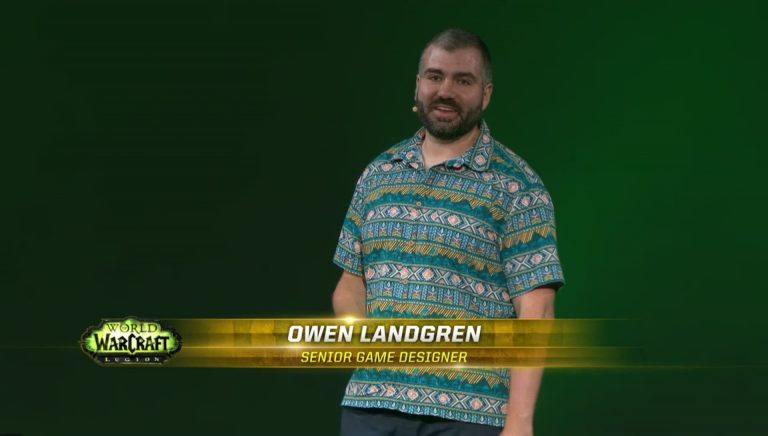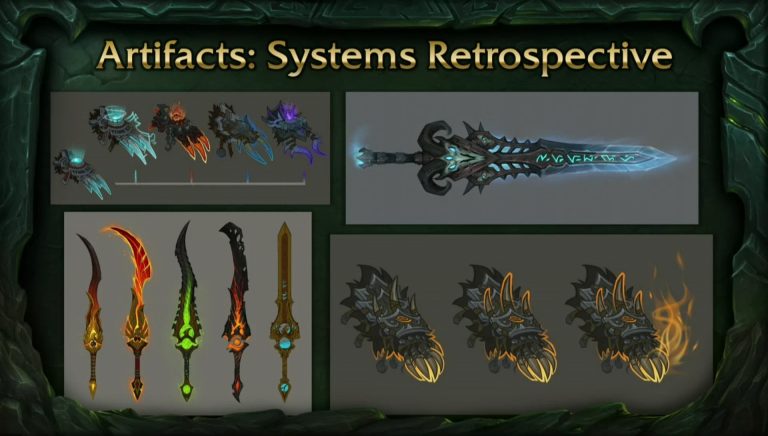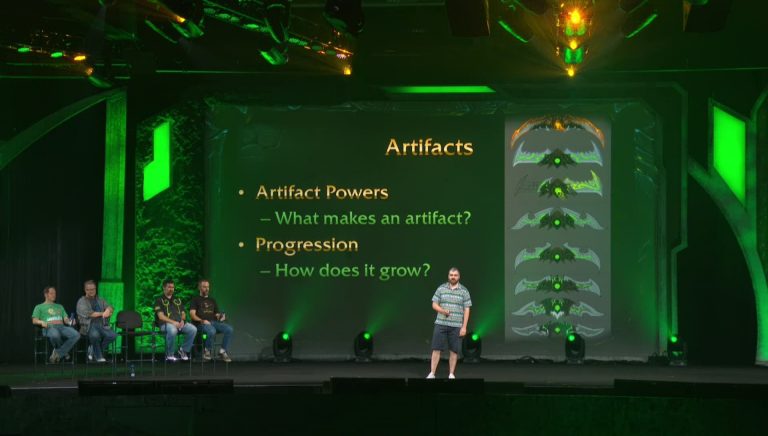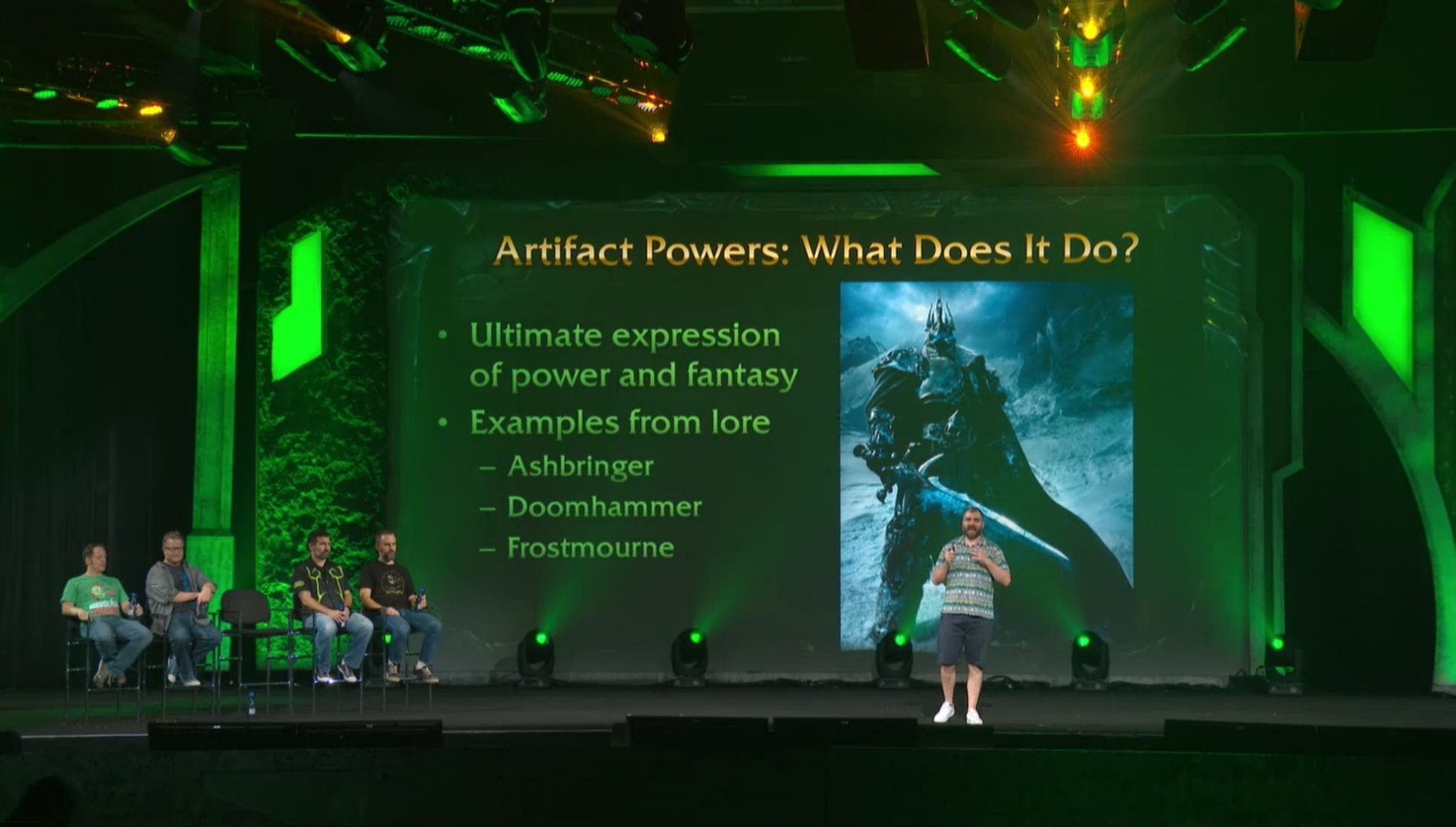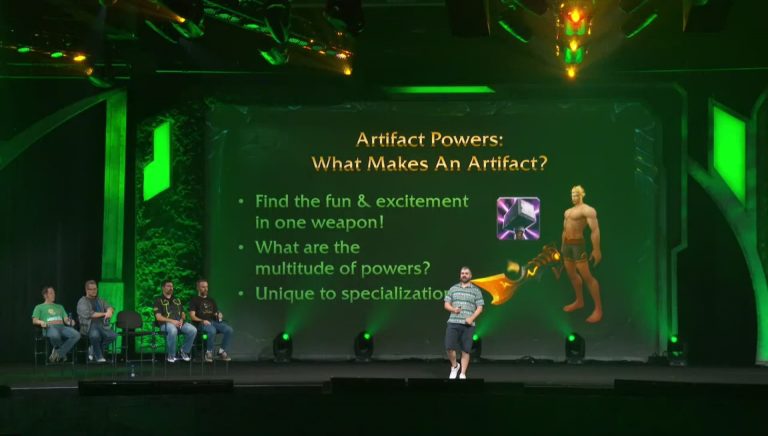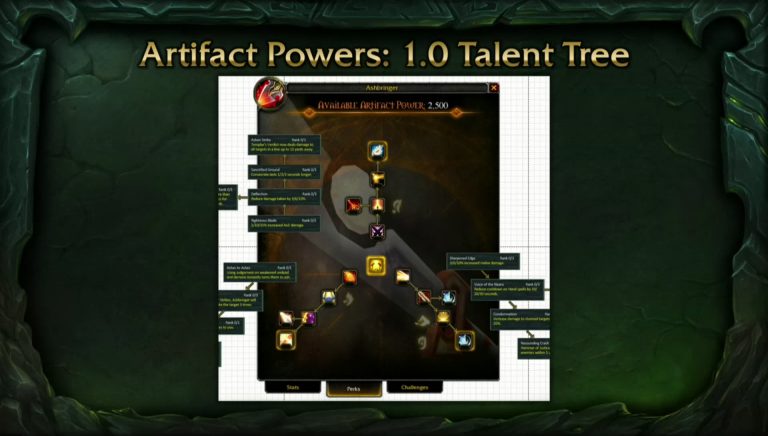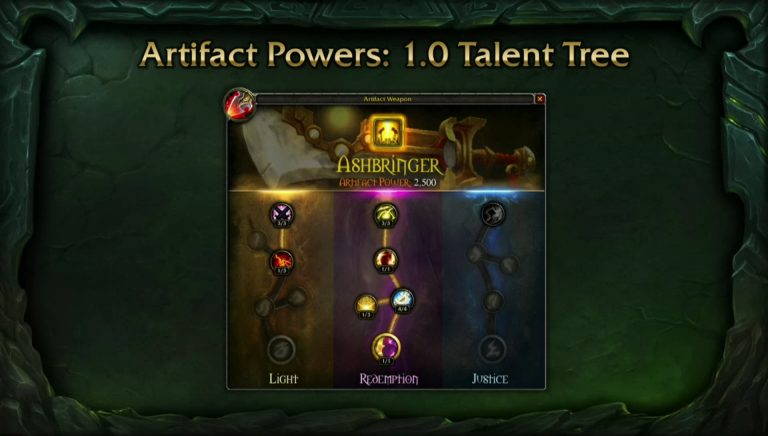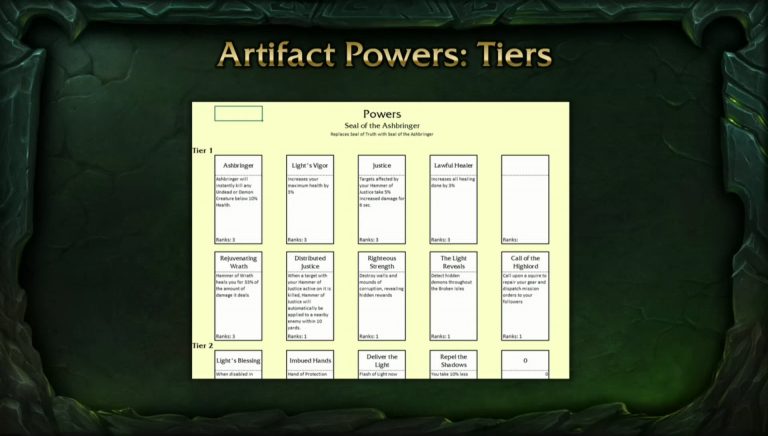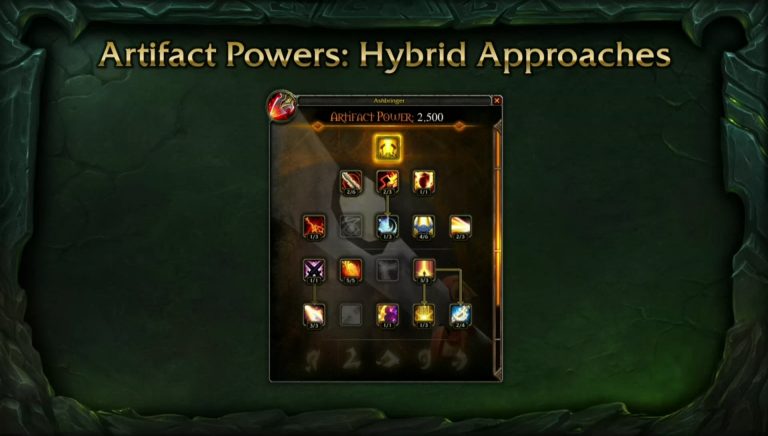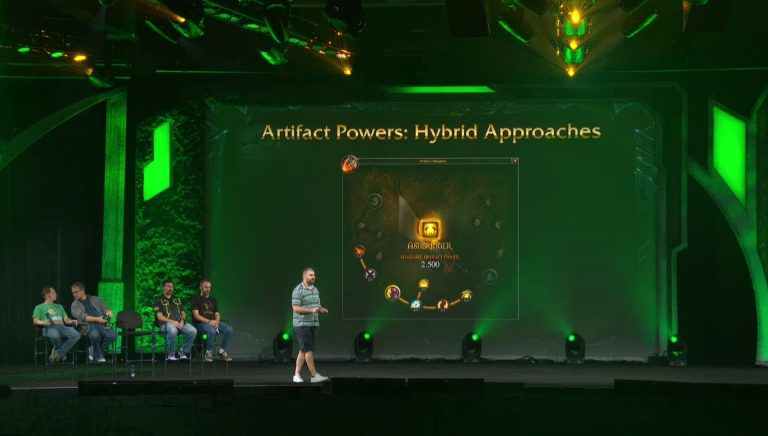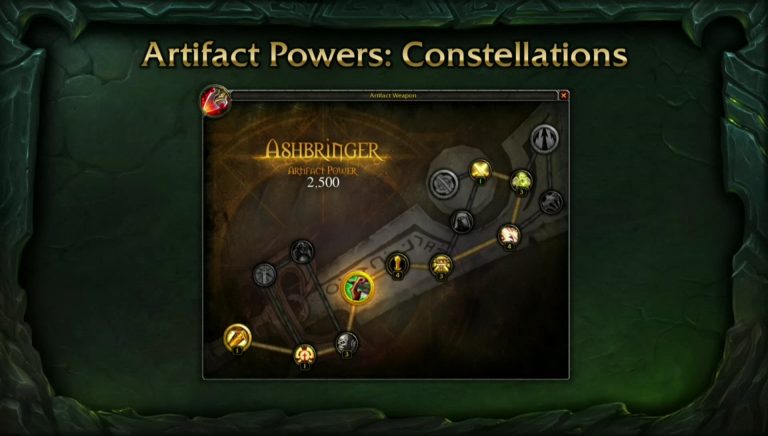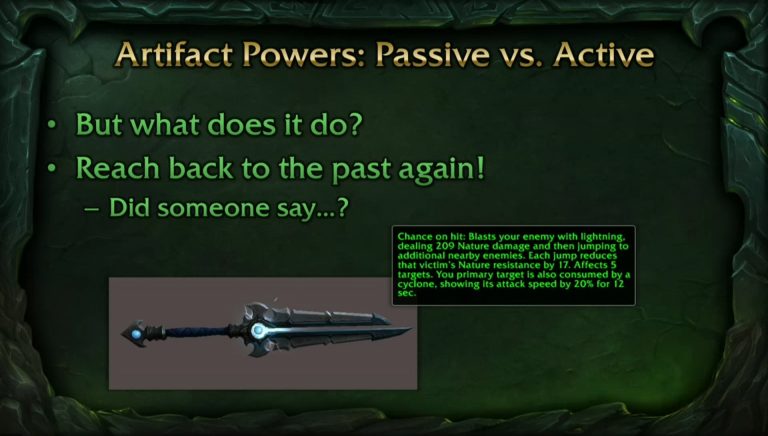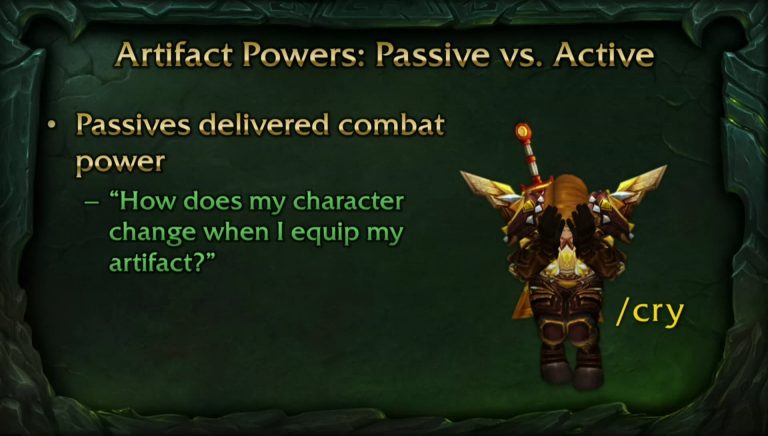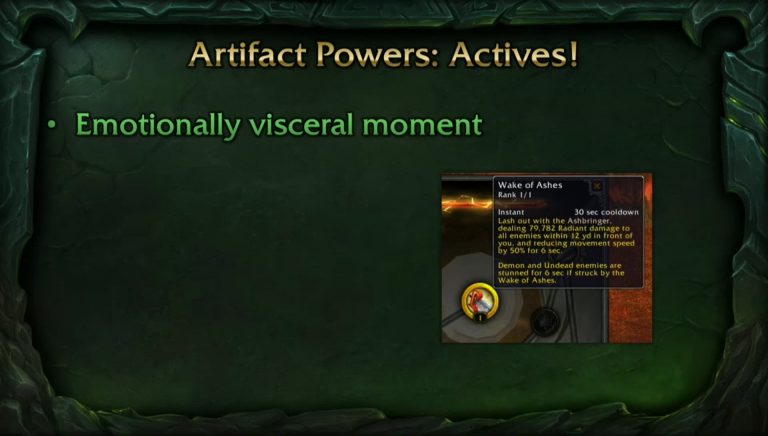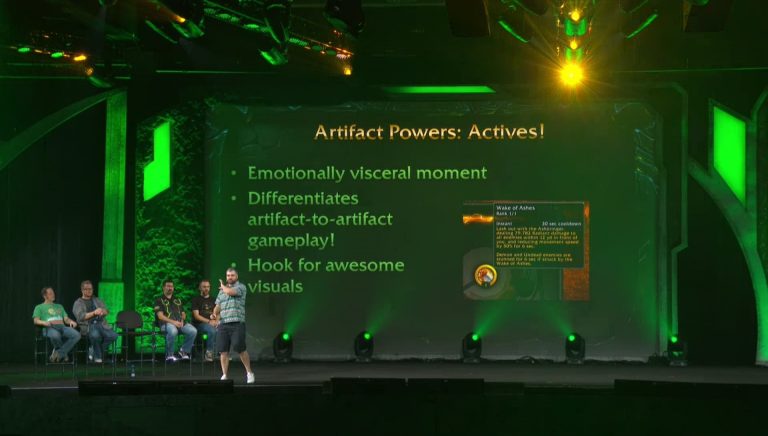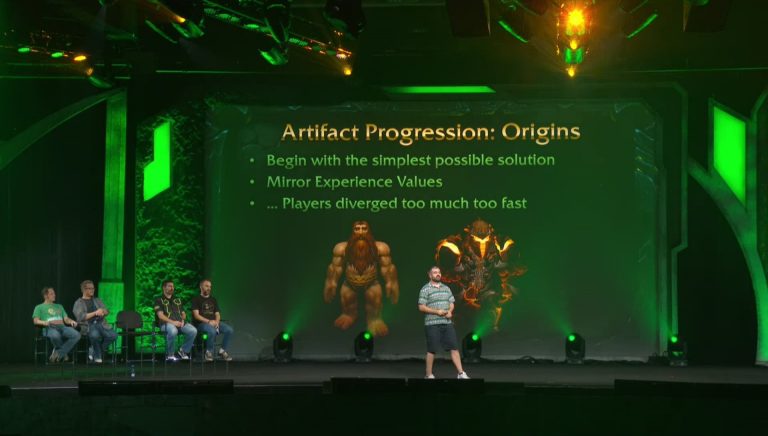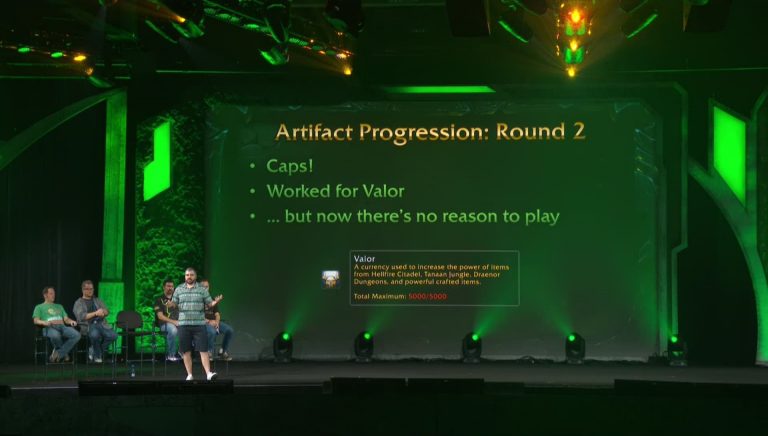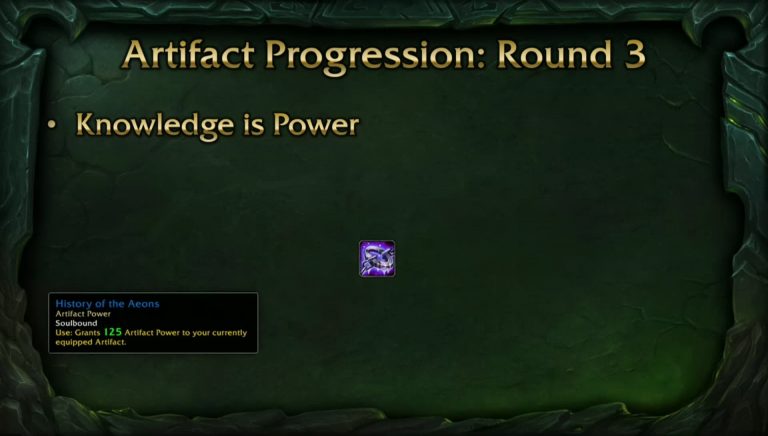Artifact Weapons
Owen: So blank slate, an empty canvas dream… when we are beginning to work an artifact weapon. That is pretty much what we have.
Thankfully, our artists are really really good at turning dreams into images and concepts and reality. And so we quickly got to work solving some of the problems.
Today, I’m going to talk to you about the artifact powers. What really makes an artifact weapon an artifact weapon? I’m going to talk to you about that whether your artifact progresses and grows with you over time.
But before I do that, I want to explore a little bit about the core values that we had for what the artifact was. We wanted this artifact to be the single most powerful thing your character had ever equipped, the item that you held in your hands and looked at, and said: “How is this possibly going to get stronger than it already is. We had examples from lore, things you had seen in the past: Ashbringer, Doomhammer, even Frostmourne.
So we had these ideas of what an artifact weapon could be, but we still really didn’t know what it would take to actually realize that; and to do that, we knew that we had to focus on concentrating equally really digging down into one particular weapon. We chose Ashbringer. We said: “Okay, we are going to build Ashbringer from the moment that you start your acquisition quest, to all of the powers that we can possibly get. We sat there and we started brainstorming. The team was just bubbling with ideas, and there were so many cool ideas for powers and stuff that we knew that we couldn’t just have one really powerful thing on that weapon. It needed to be a whole host of different ideas.
We also knew that Ashbringer wasn’t going to be something that the deathknight was holding on to, that a warrior was wielding to smash in battle, that Ashbringer was going to be purely for Retribution Paladins; and that each of these artifacts would be tied uniquely inextricably linked to your specialization, almost like a second character in a way.
So thinking about it like a second character, we said okay we have all of these cool powers that we brainstormed, we have all of these cool ideas. How are we going to present them to the player? … and so what you see up here is a very early visual, we couldn’t even put these in the game yet, we couldn’t attach them all to an item, but we had an idea.
We are saying: “Okay, we are going to make three really cool flashy powers that we are going to put at the end of these trees, and after you equip Ashbringer for the first time, you then are going to choose one of these trees, and go down; and eventually get that splashy power at the end; and so we prototyped this in-game, and it worked pretty well.
I mean classic talent trees worked pretty well themselves, but it had a core problem: as soon as you picked up Ashbringer, we were actually asking you to make a choice that drastically impacted the rest of your lovely experience, and even some of your time in end-game. And so because of that, you ended up reading all of the traits and terms: “Oh, man… this is just completely nuts!”
So we went back to the drawing board or in this case Microsoft Excel, and we said: “Hey, we’re going to try a completely different idea. Tiers of power where you buy up all of tier 1 before you can unlock things in tier 2, buy up all of tier 2 before you can unlock things in tier 3.”
We prototype this in-game and you can see there the bar on the side indicated how powerful your artifact could become over time. So we had solved the problem of forcing you to make a really intense choice, but we had also solved the problem of choice altogether. You just got to buy what you could buy into tier 1, and that wasn’t really fun at all, we then went onwards.
Okay, let’s hybridize these things, give you so many powers within each tier that you can’t possibly choose them all. Well, now you are wondering: “Should I go back to Tier 1, or pick that new cool thing in tier 3?”
We tried an arc approach with really strict dependencies that you slowly move clockwise around the artifact as Ashbringer was sitting there front and center. But that had sort of pendulum back to that original 1.0 problem where we were asking you to make a really important choice immediately, and so none of these solutions are really working; but the arc had one core element that really inspired us: Ashbringer, front and center in that UI.
And that led us to what we call: the constellation. We took the best parts from all of those different solutions that we tried, the three splashy unique gold bordered traits. The idea that eventually you could get everything from the tiers of power, the idea that there were a whole bunch of things to get from our hybridized approach, and the strict dependencies of the arc layout that let us go and map across.
So constellations, we think solved a lot of the problems and hopefully you are having fun with them today; but they took a lot of time and effort and iteration to get. So we have got our powers, we know how to present them, but what does the artifact actually do when you pick it up for the first time? What does Ashbringer do when you get to wield it, and bash those demons in the skull? Well, again, let’s look back to history, let’s look back to the things in the past: legendary weapons. We knew that legendary weapons were cool and exciting, and really represented the pinnacle of power prior to that, and all of those legendary weapons had a very strong passive effect, something that everytime you were swinging you had a chance to trigger this.
So we built that. We said: “Hey, Ashbringer is going to have an incredible power: vaporize demons every time you attack,” and it delivered the combat power, very successful at making sure that you killed stuff a lot faster, but over and over we got the feedback even from you in beta that your character hadn’t changed when you equipped your artifact. You are pressing the same buttons in the same order, and that just wasn’t acceptable for something that was supposed to be the core fantasy of what a weapon could be.
So we went back to the drawing board and gave you active abilities instead and immediately we knew that this was the right direction. The active abilities were a visceral moment where you made the choice, you invoked the power of Ashbringer, blasting demons into the ground. Further, they allowed us to differentiate much more so than the passive abilities that were triggering our spells left- right, left right.
Here Thal’kiel could suck the soul of your demons themselves and channel it into raw destructive energy, Aluneth could Implant an arcane time bomb in the heart of your enemy: tick, tick, tick, boom!!!
Finally, it gave us the ability to really amp the visuals up to eleven, because we knew that when you invoked the power of your artifact weapon, nothing else was happening. You made a conscious choice in that moment to say: “Okay, I am going to use this power,” and so you wouldn’t be Mortal Striking, you wouldn’t be Death from Aboving and you wouldn’t be Templar’s Verdicting, you would be invoking your artifact, and so we could crank the visuals up to eleven like Sinagosa’s Fury sweeping across the battlefield.
So we have our power, we know what happens when we pick up the artifacts for the first time and use it. How does the artifact actually grow and change with you? And again, we are thinking about these artifact weapons almost as characters. So what is the simplest possible solution for growing a character? Experience.
So we literally mirrored experience values, started out with a very small artifact that would get experience as you did quests and killed kobolds and vrykuls, and demons, and everything else; and it worked pretty well.
Item level increased. You got access to new powers, but it had a core problem and you were very quickly divergent from your friends and if someone played even one or two more hours than you, two or three times a week, a couple weeks later, you’d end up in a situation where you couldn’t even play with each other; and that was really sad.
So I said: “Okay, well, leveling solves this by caps… right? Leveling you go to 110. So let’s try that in this system. Let’s install a cap in the amount of artifact experience that you can earn at that time,” and it worked for valor in the past, and we heard your feedback in patch 6.4.2 that you know this was perhaps not the most fun thing in the world; but we also solved the problems of actually wanting to play a lot of the time, because you had in your hands a weapon you wanted to power up, but you couldn’t anymore; and so when you were pushing for that Mythic+ 7, or Mythic+ 8 — suddenly, you had no incentive to do that, but obviously wasn’t acceptable either.
Our next attempt was the thing that we know as artifact knowledge today. The idea that no matter when you play, no matter what you do, you can always empower your artifact. But that every day that passes as your researchers are looking into their books and scrolls, and finding out what’s going on. They are creating multipliers, making that your ability to empower the weapon even better. So this makes sure the play is always valuable, but at the same time ensures that you can’t ever diverge too far from your friends, because they are also learning how to empower their weapons better; and ultimately, that item that may have given you one bubble initially gives you 5 or 6 different power bubbles on the progression to that power.
So those are some of the challenges that we faced when we are developing the game systems behind the artifacts. I hope you’re looking forward to the challenges that you will be facing in patch 7.2, as you complete your solo challenges to get the last appearance for your weapons.
With that, I am going to hand things over to Brian Holinka who is going to tell you why Ret Paladins are totally fair and balanced in PvP, and the artifact traits for Ashbringer are… you know… pretty good.
Next: Legion PvP Goals
| BLIZZCON 2016 WORLD OF WARCRAFT: LEGION DESIGN RETROSPECTIVE PANEL TRANSCRIPT | |||||
| Early Development | Demon Hunter: Behind the Blindfold | Artifact Weapons | Legion PvP Goals | ||
| Legion Professions | World Quests | ||||
Hope you enjoyed this article. Please, support Blizzplanet via PayPal or Patreon, and follow us on Twitter, Facebook, YouTube, and Twitch for daily Blizzard games news updates. |
 |

